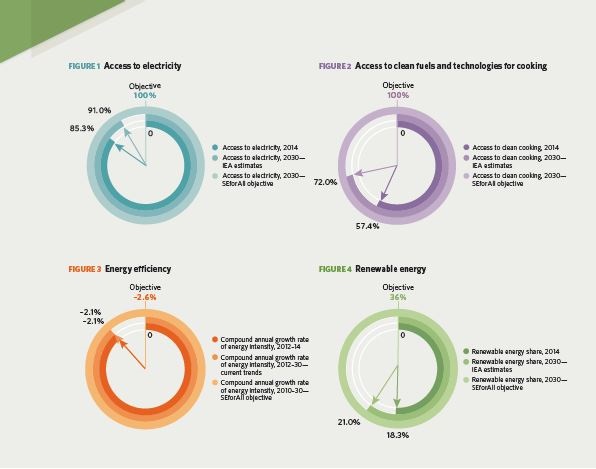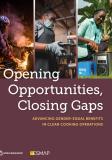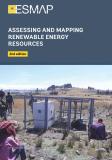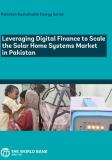Publications

The Global Tracking Framework 2017 (GTF) aims to provide the international community with a global dashboard to register progress on energy access, energy efficiency and renewable energy. It assesses the progress made by each country on these three pillars and provides a snapshot of how far we are from achieving the 2030 Sustainable Development Goals (SDG) targets.
In every area of sustainable energy, a number of countries are outperforming the world, despite slower than required progress overall to achieve global energy access, renewable energy and energy efficiency goals, a new report finds.
Entitled Global Tracking Framework 2017 – Progress Toward Sustainable Energy, the report points to the International Energy Agency’s projections to show that at the current rate of progress, only 91 percent of the world will have electricity access in 2030, while only 72 percent will have access to clean cooking. Improvements in energy intensity are also projected to fall short of the 2030 goal while the share of renewables will only reach 21 percent by that time.
Those estimates underscore the need for urgent action.
Energy is the cornerstone of economic growth. With access to modern, reliable and affordable energy, a child can study at night, small businesses can thrive, women can walk home under the safety of working streetlights and hospitals can function efficiently and save lives. That is why reaching Sustainable Energy for All’s (SEforALL) objectives of universal access to modern energy, doubling the rate of improvement of energy efficiency and doubling the share of renewable energy by 2030 is crucial.
To make meaningful improvements, higher levels of financing and bolder policy commitments, along with the willingness on countries’ part to embrace new technologies on a much wider scale are essential, according to the report.

Key findings from the GTF:
Electrification:
- In 2014, access to electricity globally climbed to 85.3 percent, up only slightly from 85.0 percent in 2012, representing a slowdown from previous years. This means that 1.06 billion people – about three times the population of the United States – still lived without access to electricity; despite the fact that 86 million people are newly getting electricity every year.
- Access to electricity in Africa is not growing as rapidly as its population. But countries like Kenya, Malawi, Sudan, Uganda, and Zambia and Rwanda, in particular, increased their electrification by 2 to 4 percentage points annually in the 2012-2014 period.
Cooking:
- In 2014, access to clean fuels and technologies for cooking climbed to 57.4 percent, up slightly from 56.5 percent in 2012. 3.04 billion people – about nine times the population of the United States – lived without access to clean cooking, which was actually slightly higher than the deficit in 2012.
- The bulk of these people live in Asia, and to a lesser extent Africa, where clean cooking does not appear to be a policy priority. Particularly striking is the case of Africa where the population grows by 20 million each year, while access to clean cooking only increases by 4 million. Relative to electricity, only a small handful of countries are showing encouraging progress on access to clean cooking, most notably Indonesia, as well as Peru and Vietnam.
Energy efficiency:
- Energy efficiency is the one area where progress accelerated from 2012-2014, leading to substantial global energy savings equivalent to the entire energy consumption of both Brazil and Pakistan in 2014. Fifteen of the world’s 20 high energy consumers reduced their energy intensity in the 2012-2014 period with countries like China, Mexico, Nigeria and the Russian Federation showing more than a 2.6 percent reduction annually.
- Driving progress in energy efficiency is strong performance from a number of major energy consuming sectors, in particular industry. Progress in transport is also encouraging as widespread adoption of fuel efficiency standards helps to drive down energy intensity particularly for passenger transportation. An important exception, however, is the residential sector that is getting more energy intensive over time.
Renewable energy:
- Overall, progress was modest on this front, with the share of renewable energy in the world’s total final energy consumption increasing slightly from 17.9 percent in 2012 to 18.3 percent in 2014. While new power generation technologies such as wind and solar are growing rapidly – representing a third of the expansion in renewable energy consumption in 2012–2014 – they are growing from a very small base, accounting for only 4% of renewable energy consumption in 2012. The challenge is to increase reliance on renewable energy in the heat and transport sectors, which account for 80 percent of global energy consumption.
- How rapidly the world’s 20 largest energy consumers meet demand with modern renewables is key to reaching this goal. In 2012-2014, only 13 of these countries succeeded in increasing their modern renewable energy share and only Italy and the United Kingdom increased their renewable energy share by more than 1 percentage point in that period.
GTF, funded by the Energy Sector Management Assistance Program (ESMAP) was produced jointly with the International Energy Agency (IEA) and in partnership with 20 partner agencies in the energy space including five United Nations Regional Economic Commissions – ECLAC, ESCAP, ESCWA, UNECA, UNECE.
The report, which has been updated every two years so far will be updated annually going forward. GTF also has a new interactive website that allows users to download data and country level reports, as well as create their own customized graphics including maps, time lines, and cross-country comparisons.
For more details and interactive data, visit gtf.esmap.org.
ESMAP. Tracking SDG7: The Energy Progress Report. https://trackingsdg7.esmap.org/



